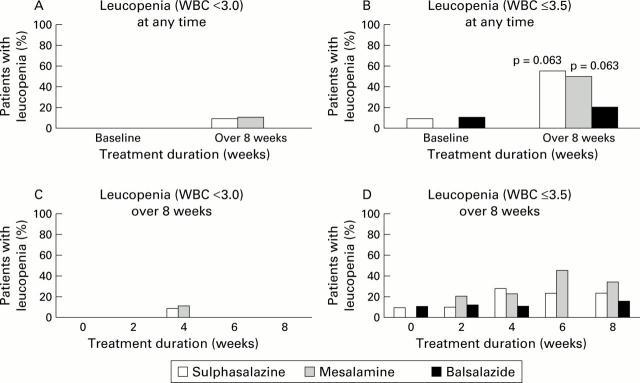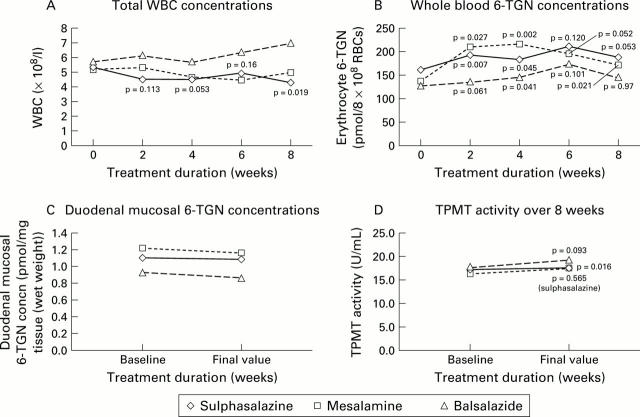Abstract
AIM—We evaluated the effect of coadministration of sulphasalazine, mesalamine, and balsalazide on the pharmacokinetics and pharmacodynamics of azathioprine and 6-mercaptopurine. METHODS—Thirty four patients with Crohn's disease receiving azathioprine or 6-mercaptopurine were enrolled in an eight week non-randomised parallel group drug interaction study and treated with mesalamine 4 g/day, sulphasalazine 4 g/day, or balsalazide 6.75 g/day. The primary outcome measure was the occurrence of clinically important leucopenia during the study, defined separately as total leucocyte counts <3.0 x 109/l and ⩽3.5×109/l. Whole blood 6-thioguanine nucleotide concentrations were determined. RESULTS—Three patients could not be evaluated for the primary outcome measure. In the remaining 31 patients, the frequency of total leucocyte counts <3.0 and ⩽3.5 were: 1/10 and 5/10 in the mesalamine group; 1/11 and 6/11 in the sulphasalazine group; and 0/10 and 2/10 in the balsalazide group. There were significant increases in mean whole blood 6-thioguanine nucleotide concentrations from baseline at most time points in the mesalamine and sulphasalazine groups but not in the balsalazide group. CONCLUSIONS—In patients with Crohn's disease receiving azathioprine or 6-mercaptopurine, coadministration of mesalamine, sulphasalazine, and possibly balsalazide results in an increase in whole blood 6-thioguanine nucleotide concentrations and a high frequency of leucopenia. Keywords: azathioprine; 6-mercaptopurine; inflammatory bowel disease; leucopenia; mesalamine; sulphasalazine; balsalazide
Full Text
The Full Text of this article is available as a PDF (209.2 KB).
Figure 1 .
Percentage of patients with Crohn's disease with clinically important leucopenia, according to treatment group. All significant differences between week 0 and subsequent time points for each of the treatment groups are indicated. (A) Clinically important leucopenia (white blood cell (WBC) count <3.0×109/l) at any time during the study. (B) Clinically important leucopenia (WBC count ⩽ 3.5×109/l) at any time during the study. The 95% confidence intervals for this end point for the mesalamine, sulphasalazine, and balsalazide groups are 19-81%, 23-83%, and 3-56%, respectively. (C) Clinically important leucopenia (WBC count <3.0×109/l) over eight weeks. (D) Clinically important leucopenia (WBC count ⩽3.5×109/l) over eight weeks.
Figure 2 .
Mean values at each study visit according to treatment group. Both significant and non-significant differences between week 0 and subsequent time points for each of the treatment groups are indicated. (A) Total white blood cell (WBC) concentrations. (B) Whole blood 6-thioguanine nucleotide (6-TGN) concentrations. Mean (95% confidence intervals) change from baseline for whole blood 6-TGN (pmol/8×108 RBCs) in the mesalamine group at weeks 2, 4, 6, and 8 were: 74 (11-136), 71 (36-106), 55 (−1-110), and 43 (8-77). Mean (95% confidence intervals) change from baseline for whole blood 6-TGN (pmol/8×108 RBCs) in the sulphasalazine group at weeks 2, 4, 6, and 8 were: 29 (10-48), 20 (1-39), 30 (−10-70), and 38 (−1-77). Mean (95% confidence intervals) change from baseline for whole blood 6-TGN (pmol/8×108 RBCs) in the balsalazide group at weeks 2, 4, 6, and 8 were: 16 (−1-33), 16 (1-31), 15 (−4-33), and −1 (−32-31). (C) Duodenal mucosal 6-TGN concentrations. (D) Red blood cell thiopurine methyltransferase (TPMT) activity.
Selected References
These references are in PubMed. This may not be the complete list of references from this article.
- Awni W. M., Braeckman R. A., Locke C. S., Dubé L. M., Granneman G. R. The influence of multiple oral doses of zileuton on the steady-state pharmacokinetics of sulfasalazine and its metabolites, sulfapyridine and N-acetylsulfapyridine. Clin Pharmacokinet. 1995;29 (Suppl 2):98–104. doi: 10.2165/00003088-199500292-00014. [DOI] [PubMed] [Google Scholar]
- Black A. J., McLeod H. L., Capell H. A., Powrie R. H., Matowe L. K., Pritchard S. C., Collie-Duguid E. S., Reid D. M. Thiopurine methyltransferase genotype predicts therapy-limiting severe toxicity from azathioprine. Ann Intern Med. 1998 Nov 1;129(9):716–718. doi: 10.7326/0003-4819-129-9-199811010-00007. [DOI] [PubMed] [Google Scholar]
- Boulieu R., Lenoir A. Determination of thiopurine nucleotides in human lung tissue by high-performance liquid chromatography. J Chromatogr B Biomed Appl. 1995 Mar 10;665(1):213–216. doi: 10.1016/0378-4347(94)00505-y. [DOI] [PubMed] [Google Scholar]
- Chan R. P., Pope D. J., Gilbert A. P., Sacra P. J., Baron J. H., Lennard-Jones J. E. Studies of two novel sulfasalazine analogs, ipsalazide and balsalazide. Dig Dis Sci. 1983 Jul;28(7):609–615. doi: 10.1007/BF01299921. [DOI] [PubMed] [Google Scholar]
- Colonna T., Korelitz B. I. The role of leukopenia in the 6-mercaptopurine-induced remission of refractory Crohn's disease. Am J Gastroenterol. 1994 Mar;89(3):362–366. [PubMed] [Google Scholar]
- Connell W. R., Kamm M. A., Ritchie J. K., Lennard-Jones J. E. Bone marrow toxicity caused by azathioprine in inflammatory bowel disease: 27 years of experience. Gut. 1993 Aug;34(8):1081–1085. doi: 10.1136/gut.34.8.1081. [DOI] [PMC free article] [PubMed] [Google Scholar]
- Cuffari C., Théorêt Y., Latour S., Seidman G. 6-Mercaptopurine metabolism in Crohn's disease: correlation with efficacy and toxicity. Gut. 1996 Sep;39(3):401–406. doi: 10.1136/gut.39.3.401. [DOI] [PMC free article] [PubMed] [Google Scholar]
- Das K. M., Eastwood M. A., McManus J. P., Sircus W. Adverse reactions during salicylazosulfapyridine therapy and the relation with drug metabolism and acetylator phenotype. N Engl J Med. 1973 Sep 6;289(10):491–495. doi: 10.1056/NEJM197309062891001. [DOI] [PubMed] [Google Scholar]
- Dubinsky M. C., Lamothe S., Yang H. Y., Targan S. R., Sinnett D., Théorêt Y., Seidman E. G. Pharmacogenomics and metabolite measurement for 6-mercaptopurine therapy in inflammatory bowel disease. Gastroenterology. 2000 Apr;118(4):705–713. doi: 10.1016/s0016-5085(00)70140-5. [DOI] [PubMed] [Google Scholar]
- Erdmann G. R., France L. A., Bostrom B. C., Canafax D. M. A reversed phase high performance liquid chromatography approach in determining total red blood cell concentrations of 6-thioguanine, 6-mercaptopurine, methylthioguanine, and methylmercaptopurine in a patient receiving thiopurine therapy. Biomed Chromatogr. 1990 Mar;4(2):47–51. doi: 10.1002/bmc.1130040202. [DOI] [PubMed] [Google Scholar]
- Irvine E. J., Feagan B., Rochon J., Archambault A., Fedorak R. N., Groll A., Kinnear D., Saibil F., McDonald J. W. Quality of life: a valid and reliable measure of therapeutic efficacy in the treatment of inflammatory bowel disease. Canadian Crohn's Relapse Prevention Trial Study Group. Gastroenterology. 1994 Feb;106(2):287–296. doi: 10.1016/0016-5085(94)90585-1. [DOI] [PubMed] [Google Scholar]
- Lennard L. Assay of 6-thioinosinic acid and 6-thioguanine nucleotides, active metabolites of 6-mercaptopurine, in human red blood cells. J Chromatogr. 1987 Dec 25;423:169–178. doi: 10.1016/0378-4347(87)80340-7. [DOI] [PubMed] [Google Scholar]
- Lennard L. The clinical pharmacology of 6-mercaptopurine. Eur J Clin Pharmacol. 1992;43(4):329–339. doi: 10.1007/BF02220605. [DOI] [PubMed] [Google Scholar]
- Lennard L., Van Loon J. A., Weinshilboum R. M. Pharmacogenetics of acute azathioprine toxicity: relationship to thiopurine methyltransferase genetic polymorphism. Clin Pharmacol Ther. 1989 Aug;46(2):149–154. doi: 10.1038/clpt.1989.119. [DOI] [PubMed] [Google Scholar]
- Lewis L. D., Benin A., Szumlanski C. L., Otterness D. M., Lennard L., Weinshilboum R. M., Nierenberg D. W. Olsalazine and 6-mercaptopurine-related bone marrow suppression: a possible drug-drug interaction. Clin Pharmacol Ther. 1997 Oct;62(4):464–475. doi: 10.1016/S0009-9236(97)90125-9. [DOI] [PubMed] [Google Scholar]
- Lowry P. W., Franklin C. L., Weaver A. L., Pike M. G., Mays D. C., Tremaine W. J., Lipsky J. J., Sandborn W. J. Measurement of thiopurine methyltransferase activity and azathioprine metabolites in patients with inflammatory bowel disease. Gut. 2001 Nov;49(5):665–670. doi: 10.1136/gut.49.5.665. [DOI] [PMC free article] [PubMed] [Google Scholar]
- Lowry P. W., Szumlanski C. L., Weinshilboum R. M., Sandborn W. J. Balsalazide and azathiprine or 6-mercaptopurine: evidence for a potentially serious drug interaction. Gastroenterology. 1999 Jun;116(6):1505–1506. doi: 10.1016/s0016-5085(99)70524-x. [DOI] [PubMed] [Google Scholar]
- Otterness D., Szumlanski C., Lennard L., Klemetsdal B., Aarbakke J., Park-Hah J. O., Iven H., Schmiegelow K., Branum E., O'Brien J. Human thiopurine methyltransferase pharmacogenetics: gene sequence polymorphisms. Clin Pharmacol Ther. 1997 Jul;62(1):60–73. doi: 10.1016/S0009-9236(97)90152-1. [DOI] [PubMed] [Google Scholar]
- Pearson D. C., May G. R., Fick G. H., Sutherland L. R. Azathioprine and 6-mercaptopurine in Crohn disease. A meta-analysis. Ann Intern Med. 1995 Jul 15;123(2):132–142. doi: 10.7326/0003-4819-123-2-199507150-00009. [DOI] [PubMed] [Google Scholar]
- Present D. H., Meltzer S. J., Krumholz M. P., Wolke A., Korelitz B. I. 6-Mercaptopurine in the management of inflammatory bowel disease: short- and long-term toxicity. Ann Intern Med. 1989 Oct 15;111(8):641–649. doi: 10.7326/0003-4819-111-8-641. [DOI] [PubMed] [Google Scholar]
- Sandborn W. J., Tremaine W. J., Wolf D. C., Targan S. R., Sninsky C. A., Sutherland L. R., Hanauer S. B., McDonald J. W., Feagan B. G., Fedorak R. N. Lack of effect of intravenous administration on time to respond to azathioprine for steroid-treated Crohn's disease. North American Azathioprine Study Group. Gastroenterology. 1999 Sep;117(3):527–535. doi: 10.1016/s0016-5085(99)70445-2. [DOI] [PubMed] [Google Scholar]
- Szumlanski C. L., Weinshilboum R. M. Sulphasalazine inhibition of thiopurine methyltransferase: possible mechanism for interaction with 6-mercaptopurine and azathioprine. Br J Clin Pharmacol. 1995 Apr;39(4):456–459. doi: 10.1111/j.1365-2125.1995.tb04478.x. [DOI] [PMC free article] [PubMed] [Google Scholar]
- Szumlanski C., Otterness D., Her C., Lee D., Brandriff B., Kelsell D., Spurr N., Lennard L., Wieben E., Weinshilboum R. Thiopurine methyltransferase pharmacogenetics: human gene cloning and characterization of a common polymorphism. DNA Cell Biol. 1996 Jan;15(1):17–30. doi: 10.1089/dna.1996.15.17. [DOI] [PubMed] [Google Scholar]
- Weinshilboum R. M., Sladek S. L. Mercaptopurine pharmacogenetics: monogenic inheritance of erythrocyte thiopurine methyltransferase activity. Am J Hum Genet. 1980 Sep;32(5):651–662. [PMC free article] [PubMed] [Google Scholar]





